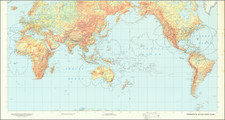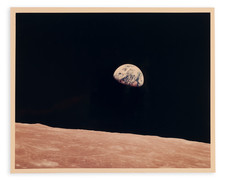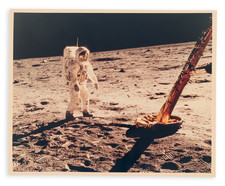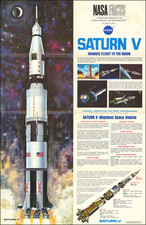This set of three Apollo Earth Orbit Charts (AEO) for the Apollo 10 Mission, dated April 16, 1969, represents a pivotal moment in space exploration, charting the precise course for May and July 1969 launch dates. Prepared under the auspices of the Department of Defense by the Aeronautical Chart and Information Center of the United States Air Force for NASA, these lithographs are foundational documents of the pre-moon landing era, detailing intricate orbital paths and tracking capabilities.
The early Apollo missions were integral to the United States' efforts in space exploration, particularly the successful landing on the moon. Apollo 10, specifically, was a critical "dress rehearsal" for the subsequent Apollo 11 moon landing, carrying out all the procedures short of actually landing. These charts document the meticulous planning and detailed routes that were required for such high-stake missions, reflecting the immense collaborative efforts between various military and scientific agencies. The charts embody the era's technological and navigational advances, highlighting the complexities of space travel and the innovative spirit of the space race era.
The charts are distinguished by their detailed legends, symbols, and notations—ranging from tracking station symbols to ground track symbols for the Apollo spacecraft. They reveal the technological capabilities of the time, including communication and radar tracking, as well as the global network of tracking stations and airfields involved in the mission's execution. Notably, the charts delineate tracking limits, command capabilities, and even specify the nominal positions for tracking ships for a particular launch date, providing a comprehensive overview of the mission's technical framework.
Apollo 10 was a May 1969 mission which acted as a practice run for the Apollo 11 mission. The mission was set up in the same way as Apollo 11 would be two months later, with a crew of two in a lunar module descending near to the surface of the moon while the main capsule remained in orbit. As such, it was the first fully manned Apollo mission to orbit the moon and the second manned orbit of the moon after Apollo 8. NASA refers to the mission as "an actual crewed landing, except [for] the landing."
The mission was manned by John Young, Thomas Stafford, and Gene Cernan, with the latter two commanding the lunar module while the former stayed in the command module. All three of them would return in later Apollo missions despite some issues with NASA management which highlighted the politics of the program.
NASA was worried that the astronauts would attempt to land on the moon, and, as such, they decided to short fuel the lunar module. The module had approximately ten percent less fuel than the Apollo 11 mission, just enough to complete the mission. Had they attempted to land, they would be left unable to return to the command module. The astronauts arrived within 8.4 kilometers of the moon and collected important information regarding the moon's gravitational field, allowing for calibration of the Apollo 11 landing system.
This mission was part of an ongoing collaboration between Charles Schultz and NASA. After trying to rebuild their public image in the wake of the Apollo 1 disaster, NASA chose Snoopy as their safety mascot. Apollo 10's lunar module was named Snoopy, and its command module Charlie Brown.













![[Moon rock or boulder from the Apollo 16 mission, numbered AS16-108-17694.]](https://storage.googleapis.com/raremaps/img/small/93459.jpg)
![[French-Russian Soyuz T-6 Flight Poster] Советско-Французский Космический Полет 1982](https://storage.googleapis.com/raremaps/img/small/68336.jpg)

